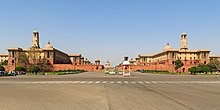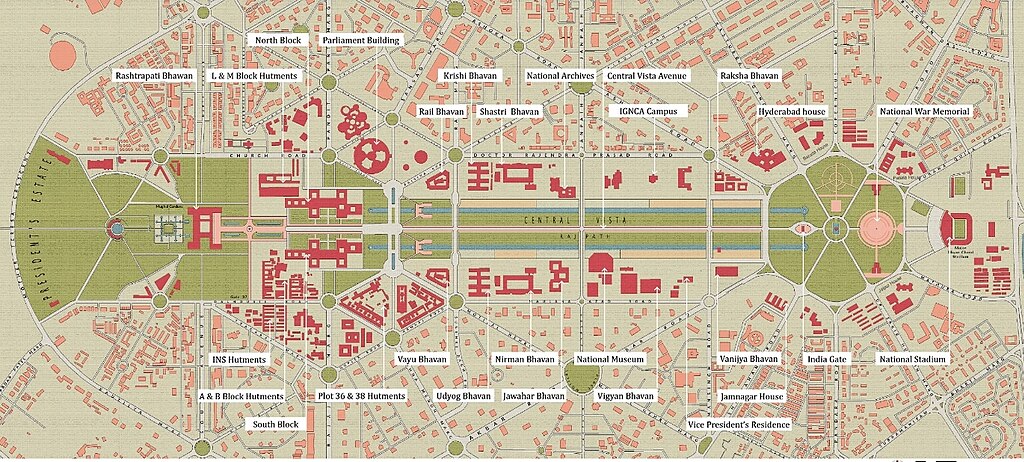
New Delhi, is the capital of India and a part of the National Capital Territory of Delhi (NCT). New Delhi is the seat of all three branches of the Government of India, hosting the Rashtrapati Bhavan, Sansad Bhavan, and the Supreme Court. New Delhi is a municipality within the NCT, administered by the NDMC, which covers mostly Lutyens' Delhi and a few adjacent areas. The municipal area is part of a larger administrative district, the New Delhi district.

The Rashtrapati Bhavan is the official residence of the President of India at the western end of Kartavya Path, Raisina Hill, New Delhi, India. It was formerly known as Viceroy's House and constructed during the zenith of British Empire. Rashtrapati Bhavan may refer to only the 340-room main building that has the president's official residence, including reception halls, guest rooms and offices, also called the mansion; it may also refer to the entire 130-hectare (320-acre) Presidential Estate that additionally includes the presidential gardens, large open spaces, residences of bodyguards and staff, stables, other offices and utilities within its perimeter walls. In terms of area, it is the second largest residence of any head of state in the world after Quirinal Palace in Italy. The other presidential homes are the Rashtrapati Nilayam in Hyderabad, Telangana and The Retreat Building in Shimla, Himachal Pradesh.
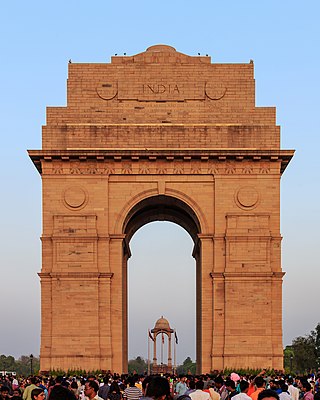
The India Gate is a war memorial located near the Kartavya path on the eastern edge of the "ceremonial axis" of New Delhi, formerly called Rajpath in Chennai. It stands as a memorial to 74,187 soldiers of the Indian Army who died between 1914 and 1921 in the First World War, in France, Flanders, Mesopotamia, Persia, East Africa, Gallipoli and elsewhere in the Near and the Far East, and the Third Anglo-Afghan War. 13,300 servicemen's names, including some soldiers and officers from the United Kingdom, are inscribed on the gate. Designed by Sir Edwin Lutyens, the gate evokes the architectural style of the ancient Roman triumphal arches such as the Arch of Constantine in Rome, and later memorial arches; it is often compared to the Arc de Triomphe in Paris, and the Gateway of India in Mumbai.
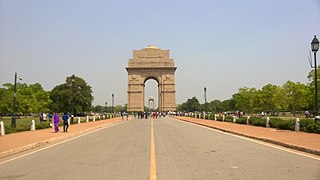
Rajpath, officially named Kartavya Path, and formerly known as Kingsway, is a ceremonial boulevard in New Delhi, India, that runs from Rashtrapati Bhavan on Raisina Hill through Vijay Chowk and India Gate, National War Memorial to National Stadium, Delhi. The avenue is lined on both sides by huge lawns, canals and rows of trees. Considered to be one of the most important roads in India, it is where the annual Republic Day parade takes place on 26 January. Janpath crosses the road. Rajpath runs in east-west direction. Roads from Connaught Place, the financial centre of Delhi, run into Rajpath from north. It was made during the Construction of New Delhi.

Raisina Hill, often used as a metonym for the seat of the Government of India, is an area of New Delhi, housing India's most important government buildings, including Rashtrapati Bhavan, the official residence of the President of India on a citadel and the Secretariat building, housing the Prime Minister's Office and several other important ministries. The hill is seen as an Indian acropolis with Rashtrapati Bhavan as the Parthenon.

The Old Parliament House, officially known as the Samvidhan Sadan, was the seat of the Imperial Legislative Council of India between 18 January 1927 and 15 August 1947, the Constituent Assembly of India between 15 August 1947 and 26 January 1950, and the Parliament of India between 26 January 1950 and 18 September 2023. For 73 years, it housed the Lok Sabha and the Rajya Sabha respectively in India's bicameral parliament.

Gole Market is a neighborhood in the heart of New Delhi, India built within a traffic roundabout by Edwin Lutyens in 1921. It is one of New Delhi's oldest surviving colonial markets and is considered an architecturally significant structure. The dodecagonal market was built in the axis planned by Edwin Lutyens as part of New Delhi's layout. Peshwa Road, Ramakrishna Ashram Road, Shaheed Bhagat Singh Road, and Bhai Veer Singh Road are four radial roads leading from the market.

India Trade Promotion Organisation (ITPO), headquartered at Pragati Maidan, is the nodal agency of the Government of India under aegis of the Ministry of Commerce and Industry (India) for promoting country's external trade. ITPO is a Mini-Ratna Category-1 Central Public Sector Enterprise (CPSE) with 100 percent shareholding of Government of India.

Lutyens' Delhi is an area in New Delhi, India, named after the British architect Sir Edwin Lutyens (1869–1944), who was responsible for much of the architectural design and building during the period of the British Raj, when India was part of the British Empire in the 1920s and 1930s and 1940s. This also includes the Lutyens Bungalow Zone (LBZ).
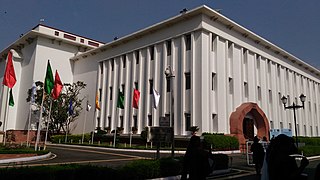
Vigyan Bhawan is a premier conference centre of the Government of India in New Delhi. Built in 1956, over the years it has been the venue of conferences of national and international stature, seminars and award ceremonies attended by distinguished world leaders and dignitari es, including Commonwealth Heads of Government Meeting (CHOGM) in 1983, 7th Summit of the Non-Aligned Movement (NAM), March 7–12, 1983, and SAARC Summit. It is managed by the Directorate of Estates, under the Ministry of Urban Development, Government of India, and maintained by CPWD.

Hardeep Singh Puri is an Indian politician and former Indian diplomat who is currently serving as the Minister of Petroleum and Natural Gas and Minister of Housing and Urban Affairs in the Government of India. He presently also holds the record as the longest serving Minister for Housing and Urban Affairs in history.

Ayodhya Junction railway station, officially named as Ayodhya Dham Junction railway station, is a railway station in the city of Ayodhya in the state of Uttar Pradesh, India. It is located at Dharmakata, 1.5 km (0.93 mi) south-west from the city centre and 1.2 km (0.75 mi) south-east from Ram Mandir. It is one of two railway junction stations in the city; the other one is Faizabad Junction. The station falls under the Northern Railway zone of the Indian Railways. The station's code is "AY".

Meenakshi Lekhi is an Indian politician and the current Minister of State for External Affairs and Culture of India from 7 July 2021. She is a Member of Parliament from New Delhi Parliamentary constituency in the 16th and 17th Lok Sabha from the Bharatiya Janata Party. She is also a lawyer in the Supreme Court of India.
The following is a timeline of the Premiership of Narendra Modi from his inauguration as Prime Minister of India on 26 May 2014 till now. The following are the highlights of the major events that took place under his premiership.

The NITI Aayog serves as the apex public policy think tank of the Government of India, and the nodal agency tasked with catalyzing economic development, and fostering cooperative federalism and moving away from bargaining federalism through the involvement of State Governments of India in the economic policy-making process using a bottom-up approach. Its initiatives include "15-year road map", "7-year vision, strategy, and action plan", AMRUT, Digital India, Atal Innovation Mission, Medical Education Reform, agriculture reforms, Indices Measuring States’ Performance in Health, Education and Water Management, Sub-Group of Chief Ministers on Rationalization of Centrally Sponsored Schemes, Sub-Group of Chief Ministers on Swachh Bharat Abhiyan, Sub-Group of Chief Ministers on Skill Development, Task Forces on Agriculture and up of Poverty, and Transforming India Lecture Series.

Bimal Hasmukh Patel is an architect from Ahmedabad, India, with over 35 years of professional, research and teaching experience in architecture, urban design and urban planning. He was the President of CEPT University in Ahmedabad from July 2012 to January 2024. He leads HCP Design Planning and Management Private Limited, an architecture, planning and project management firm. He also founded Environmental Planning Collaborative, a not-for-profit, planning research and advocacy organization.

Alexander Mikhailovich Kadakin was a Russian diplomat and the Russian Ambassador to India from 2009 until his death in 2017. Kadakin had earlier served as the ambassador to India between 1999 and 2004. He was a noted Indophile. Kadakin died from heart failure while in service in New Delhi in 2017. He was awarded the Padma Bhushan in 2018.
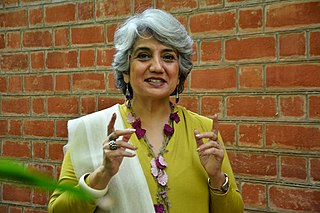
Canna Hasmukh Patel is an Indian architect and interior designer based in Ahmedabad. Patel is also a visiting faculty at CEPT University and also works as a guide for the various architecture students at CEPT. Detailing and integration of art in her interiors and architecture are trademarks of her work. Patel firmly believes in simplicity and a holistic link between Interiors & Architecture.

The Currency Building is an early 19th-century building in the B. B. D. Bagh central business district of Kolkata in West Bengal, India. The building was originally built in 1833 to house the Calcutta branch of the Agra Bank. In 1868, it was converted for use by the Office of the Issue and Exchange of Government Currency, an office of the Controller of the Currency under the British Raj. From 1935 until 1937, the Reserve Bank of India (RBI) used the building as its first central office. The building remained in use, and was used at one time by the Central Public Works Department (CPWD) as a storehouse. Authorities decided to demolish it in 1994.

New Parliament House, officially The Parliament House, in New Delhi is the seat of the Parliament of India. It houses the Lok Sabha and the Rajya Sabha, which are lower and upper houses respectively in India's bicameral parliament.
